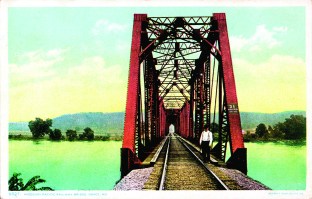Recently, Union Pacific Railroad officials with the Federal Railroad Administrator and guests from Amtrak and the Missouri Department of Transportation gathered in Osage City to celebrate the completion of a new bridge over the Osage. According to their press release, the addition of a new 1,200 foot span “will eliminate the rail line’s last chokepoint between Jefferson City and St. Louis.”
 The original iron truss railroad bridge over the Osage carried traffic only one direction at a time, making trains wait for others to cross before proceeding. The center span once could be raised to accommodate steamboat traffic. This image of the original bridge was taken in 2010. (page 73, Damming the Osage).
The original iron truss railroad bridge over the Osage carried traffic only one direction at a time, making trains wait for others to cross before proceeding. The center span once could be raised to accommodate steamboat traffic. This image of the original bridge was taken in 2010. (page 73, Damming the Osage).
An aerial photo from the Missouri Department of Transportation shows the new span being built next to it.
 In the push westward a hundred or more years ago, avenues of transportation for people and products were explored, promoted and built. Jumping off points to the opening West included Osceola and St. Joseph as well as Westport (Kansas City) Missouri. Local promoters sought improvements to the Osage for steamboats like the ill-fated and ill-purposed Lock and Dam No. 1. The rocky hills and narrower alluvial valley of the Osage River precluded railroad construction for the most part.
In the push westward a hundred or more years ago, avenues of transportation for people and products were explored, promoted and built. Jumping off points to the opening West included Osceola and St. Joseph as well as Westport (Kansas City) Missouri. Local promoters sought improvements to the Osage for steamboats like the ill-fated and ill-purposed Lock and Dam No. 1. The rocky hills and narrower alluvial valley of the Osage River precluded railroad construction for the most part.
But railroads overcame steamboats as efficient movers of goods and immigrants. The alluvial plain along the Missouri River was broad enough to allow for building tracks and the link from St. Louis to Kansas City made the straightest route. That same route today carries 60 daily freight trains and Amtrak’s Missouri River Runner between the two metropolises.












